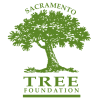Chronicles of the Sacramento elms, part 1
by Chris Fenstermaker, Volunteer
March 28, 2018

Sacramento, the City of Trees. Our streets canopied by that signature tree. The stately… birch? The stately… poplar? No, stately only comes to mind to describe the elm! The elm marched across the American landscape in the 1800s as town squares embraced English-style rectangular brick building designs and cultural centerpiece trees like elms. Elms have come to represent the finest arboreal visage of our urban centers.
Politicians and poets, among others, have praised the elm for its contribution to our cities’ environments: “We walk in the shade of its lofty, spreading dome” (Thoreau); “We had rather walk beneath an avenue of elms than inspect the noblest cathedral that art ever accomplished” (H. W. Beecher). A stately tree, indeed.
As a practical matter, the spreading dome of the elm and other trees in downtown areas have played a significant role in lowering surface temperatures. The state gardener at Capitol Park had this to say in an August 1927 Sacramento Bee article: “The tree-lined streets of Sacramento are certainly a blessing to her citizens, while visitors are delighted with the beauty and comfort of these trees on summer days. One of the favorite shade trees is the elm.”
Sadly, disease is another word we associate with the elm. Dutch elm disease (DED) appeared in Sacramento in 1990, after first appearing in the Bay Area 20 years earlier. A fungus spread by elm bark beetles as well as root grafts (the fungus can be spread by root-to-root contact between trees), DED has wreaked havoc on Sacramento’s elm population. Along with the aging and death of 100+ year old elms, the signature tree of the capital city has been reduced from an estimated 25,000 elms (public trees) to approximately 2,000 – still more than any other city in California, but clearly an alarming loss.

This loss triggered a community-wide response – concerned citizens, city and state agencies, and businesses all banded together to tackle DED. The Sacramento Tree Foundation led this effort by creating the Save the Elms Program (STEP) in 1995 and enlisted volunteers to monitor the health of the city’s elms. For three years, STEP volunteers helped identify public elm trees that had signs of DED and reported this information to the City of Sacramento before state budget cuts put an early end to the program.
Since the 90s, Sacramento has continued to lose elms to DED, a problem only exasperated by many years of drought. However, conversations between the City of Sacramento, nationally recognized arborists, and the Sacramento Tree Foundation sparked a new energy in saving these stately trees. Through our renewed Save the Elms Program (STEP) sponsored by the City of Sacramento, we continue to train volunteers as community scientists who can help us identify early signs of DED in our community. Find out how you can become a guardian of these beloved icons of Sacramento.
